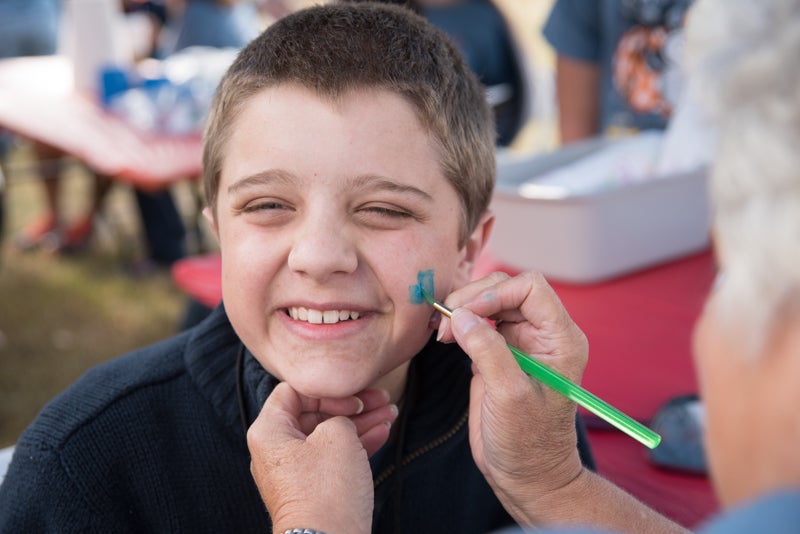Take a walk through Montevallo
Published 12:00 am Tuesday, May 27, 2003
Ghosts, art, history galore on local city walking tour
By Fred Guarino/Reporter Staff Writer
About 20 people came from as far away as Hoover and Birmingham to participate in the first free guided Saturday morning walking tour of Montevallo this past weekend.
Montevallo is one of 30 Alabama communities offering tours as part of Gov. Bob Riley’s mission to increase awareness of Alabama’s culture and history.
The walks, led by community leaders, will begin at 10 a.m. each Saturday through the Fourth of July weekend.
This past weekend’s Montevallo tour was led by Montevallo Mayor Grady Parker with assistance from Ben McCrory, executive director of the Montevallo Chamber of Commerce, and from Bruce McClanahan of the House of Serendipity.
The schedule of remaining Montevallo tours will be led by: May 31, Dr. Robert McChesney, president of the University of Montevallo; June 7, Cynthia Shackelford, public relations director for UM; June 14, Sharon Anderson, member of the Montevallo City Council;
June 21, McCrory; June 28, Dr. Norman McMillan, UM professor emeritus of English and author; and July 5, Dr. Mike Mahan, dentist and historian.
The tour begins with a welcome at the Montevallo Chamber of Commerce office
located in the Will Lyman House at 720 Oak Street and includes the following sites in the city of Montevallo and on the UM campus: First United Methodist Church; Calkins Hall; Reynolds Hall; &uot;Becoming&uot; (a 16-feet-tall original bronze sculpture by Ted Metz); the star marking the geographic center of
the state of Alabama on the steps of Main Hall; King House; the world’s largest geode; King Family Cemetery; Montevallo Post Office; original cedar carvings in Orr Park; First Baptist Church; and the House of Serendipity.
The Will Lyman House is a two-story Victorian wood structure in the East Lake style, which was constructed in 1886.
The Lyman family housed boarding students there for the Alabama Girls’ Industrial School (later the University of Montevallo). Members of the Lyman family played a role in the development of the city, with three members of the family serving as mayors of the city.
According to present day Mayor Parker, Will Lyman was the first mayor after reconstruction following the Civil War.
The Lyman home passed into the hands of the university in the 1930s, was restored with grant support in 1995 and has served as a residence for faculty and students, a school infirmary, a speech and hearing clinic and an art annex.
Today, the structure houses the university’s welcome center, public relations department, student publications and the Montevallo Chamber of Commerce and is listed on the National Register of Historic Places.
The First United Methodist Church of Montevallo was founded in May 1818, one year before the state of Alabama was born. The church, currently located at the intersection of Middle and Oak Street, was constructed in 1907 in Gothic revival style. The sanctuary houses an Earnest Skinner organ with 1,037 pipes purchased from a church in Selma and later rebuilt.
Calkins Hall on the UM campus, built in 1917 in the Williamsburg style, now serves as the office building for UM President Dr. Robert McChesney and three of the university’s four vice presidents.
A medallion design on each side of the upper story of the two-story building features a music lyre, a symbol of its music history. Calkins Hall is also listed on the National Register of Historic Places.
Reynolds Hall on the UM campus, also listed on the register, was built in 1851 and is said to be haunted. The brick used in its two-story construction was burned locally for that purpose. It is named for the first president of the university, Capt. Henry Clay Reynolds, and was originally a private boys’ school.
It became the first instructional building, however, of the Alabama Girls’ Industrial School in 1896 and was a gift from the town in return for locating the school in Montevallo. The wings were added shortly after the school opened.
Reynolds Hall today houses the alumni and development office, the UM Foundation and the department of communication arts (including a small second floor theater). Stories of Capt. Reynolds’ ghost have also become legend at UM.
A popular attraction on the walking tour is the 16-feet-tall, 5,000-pound bronze Ted Metz sculpture &uot;Becoming.&uot; The sculpture, located on campus near the arch of the Bowers Colonnade, includes two hands &045; one of a student reaching skyward and another, more mature hand is that of a teacher, falling back and indicating the student’s graduation. The keys held by the fingers represent the possession of knowledge.
Metz has been a UM faculty member for 30 years and some 40 of his art students participated in the 22-month construction of the giant sculpture.
Main Hall on the UM campus was constructed in three phases between 1897 and 1908. It held the distinction at one time of being the largest female residence hall in the deep south. The central section is noted for its wisteria-covered rounded arches over the main entrance. A grand staircase restored in 1896 is the focal point of the foyer.
A star emblazoned on the first step of Main Hall is said to mark the near geographic center of the state of Alabama.
Like Reynolds Hall, Main is said to be haunted … by the ghost of a student who lived there nearly 100 years ago.
The King House, located on the UM campus and listed on the National Register of Historic Places, is sometimes called Kingwood. It was home to Edmund King, one of one of
earliest settlers to central Alabama.
King, a native of Virginia, first came to Alabama in 1817, moving his family from Georgia to what is modern day Montevallo.
The house was built in 1823 from bricks made at Shoal Creek. It featured the first glass windows in the territory.
King House was built in the Federalist style and included two rooms over two rooms with a stair and hall between. A summer kitchen behind the house was added
later.
During the Civil War, soldiers from both the Union and Confederate armies took refuge at the home and Aaron Burr is reported to have slept there.
The home was eventually sold to the Alabama Girls’ Industrial School. It was used an infirmary, a laboratory, offices and classrooms.
In 1973, due to the involvement of Mrs. Kermit Johnson, wife of then UM President Johnson, the home was restored with funds from a federal grant.
King House is now used as the official guesthouse for the university and is also the setting for receptions, meetings and teas.
Near King House is King Cemetery. There are 10 marked graves within the blue limestone wall. The grave of Edmund King, who died a week before the Battle of Gettysburg in 1863, is marked by a shaft of marble.
A partial reading of his gravestone reveals: &uot;Edmund King was born in Va., removed to Ga., and married Nancy Ragan in 1812, came to Ala. in 1817 and settled on this place where he died June 28, 1863.&uot;
The University of Montevallo is also home to the world’s largest known geode, a nodule of stone with a cabity filled with minerals.
Located in the atrium of Harman Hall, it weighs eight tons (16,000 lbs.) and is composed of the iron oxide minerals (Hematite, Goethite and Limonite).
It was unearthed in an iron quarry in Northwest Shelby County in 1965 and donated to the University of Montevallo by Shook and Fletcher Mining Company and the Shelby County Highway Department.
The Montevallo Post Office, constructed in 1937, is reportedly the only federally owned building in Shelby County. The father of Montevallo Mayor Grady Parker did the original electrical work on the building.
Inside is a mural painted by William S. McCall in 1939. He was commissioned by the U.S. Department of the Treasury. The mural depicts Shelby County settlers weighing cotton in the field.
One the most pleasant spots on the tour is Orr Park where children splash gleefully in Shoal Creek and some 35 original tree carvings by Tim Tingle have created an outdoor art gallery. Tingle is an artist, author and coal miner. The carvings include various faces, a squirrel, a fish swallowing a snake, beetle, horse head, alligator, totem pole, owl, unicorn, wizard and Indian.
The First Baptist Church of Montevallo was founded in 1855. The church at its present site began as a wooden structure with additional buildings added during the years. The baptistry dates to 1900.
The last stop on the tour was the House of Serendipity, located in a building constructed in 1922. It first housed Jeter-Davis Mercantile. The balcony included a millinery shop and undertaking business. Today the building is the House of Serendipity, which opened in 1977, owned by Bruce and Jane McClanahan.
Among those taking the tour last weekend was Shelby County author Walter Adkins, whose book &uot;Walking Home From Rock Island&uot; can be purchased at the House of
Serendipity.
For information on other city tours see the website www.touralabama.org.
Participating cities include Albertville, Ashland, Auburn, Birmingham, Decatur, Dothan, Enterprise, Eufaula, Florala, Florence, Foley, Fort Payne, Greensboro, Greenville, Huntsville, Jacksonville, Marion, Mentone, Monroeville, Montevallo, Montgomery, Opelika, Selma, Springville, Thomasville, Troy, Tuscumbia, Tuskegree, Union Springs, Valley and Wetumpka.
The Montevallo Chamber of Commerce can be reached at 665-1519






